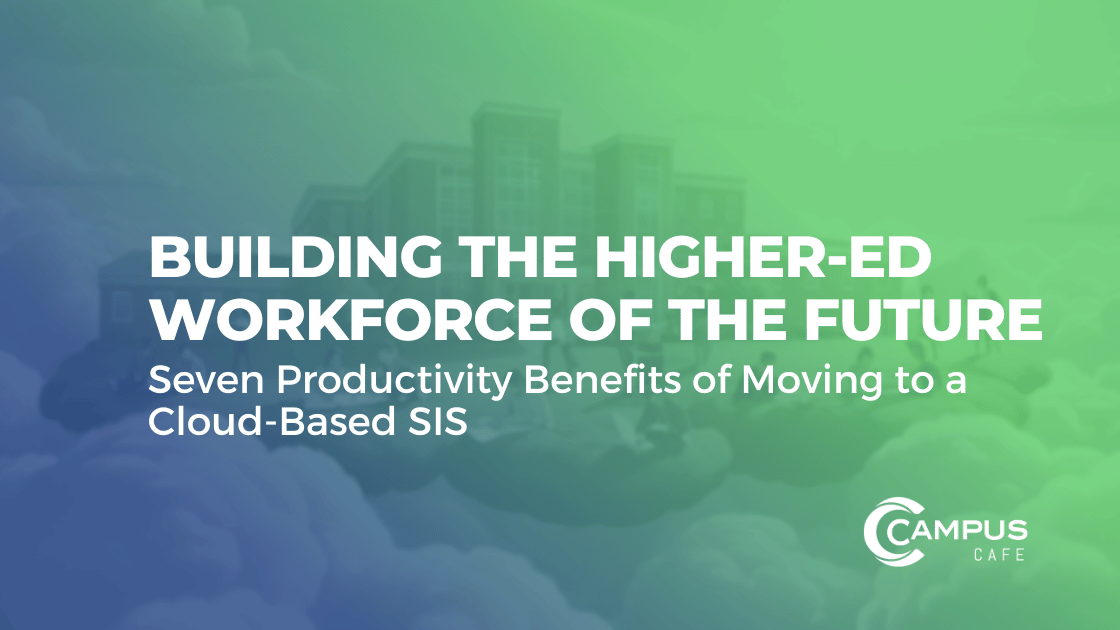
Today, many working professionals prefer remote work and flexible schedules. In higher education, the ability for staff to work remotely represents a fundamental shift away from campus culture, which is the nerve center for any school. By offering flexible work arrangements, schools and colleges can recruit staff from a wider talent pool, retain employees and promote work-life balance.
But instituting a remote work culture doesn’t just happen overnight; there are technological and change management hurdles that need to be considered to accommodate off-site work. A cloud-based student information system gives all stakeholders the tools, resources and security to make a smooth transition to working off-campus or on flexible schedules.
Remote Work is a Competitive Advantage in a Tight Job Market
More American professionals are working from home or remote locations than ever before – and many of them like it that way. According to a recent McKinsey survey on flexible work, 87 percent of American workers who are offered flexible work arrangements take their employers up on the offer.
Those sentiments also extend to higher education. The McKinsey study surveyed professionals across 20 industries, including education, and nearly half of those respondents said they currently work remotely either full-time or part-time.
That’s a major shift from pre-pandemic levels. Historically in higher education, schools have required their staff to work on site. After all, a campus is the hub for activity and operations for students, faculty and staff. Following the pandemic, which forced schools to transition to remote work to continue operations, many staffers wanted to retain the option to work remotely or on a flexible schedule after campuses reopened.
In fact, a desire for flexibility is driving some higher education employees to hit the job market. In a report by the College and University Professional Association for Human Resources that surveyed higher-ed employees searching for new positions, 42.9% said they wanted the opportunity to work remotely and 31.7% were seeking a flexible schedule.

Six Benefits of a Cloud-Based Student Information System
Cost, ease of use and data security are the most important factors when updating to a cloud-based student information system.
Challenges for Schools to Adopt a Remote Work Culture
Schools must not only consider the needs of their employees, but they also have to address the technological challenges that come with off-campus work. Many schools have outdated student information systems and IT infrastructure that can’t handle remote access and file sharing, or lack mobile-friendly software so employees can check emails and login from their devices.
Also, if a school’s student information system uses physical servers on campus, it is harder for remote workers to access and collaborate on projects. And if the servers go down, their work could be lost. Without a centralized platform, it’s difficult for higher-ed staffers to securely and conveniently work remotely.
Even if your school’s technology wasn’t ready for employees to work remotely and your school had to adapt to the transition, it’s likely that offsite workers are struggling with inefficiencies that are wasting time and money. For example, on Tuesday an employee begins work on a spreadsheet and then emails it to two colleagues in different time zones. The next morning, she adds updated information and resends it, but one coworker has already started editing the original document. Now the team is working on different versions and doing twice the work.
Additionally, for employees who need remote access to third-party apps (like learning management systems) that won’t or don’t integrate with your student information system, the the data won’t be up to date or accurate for students or faculty, which is frustrating for everyone.
Simply put, if your school has outdated tech, you’re not only behind the latest IT and hiring trends, but also jeopardizing the security and accuracy of your data.
How the Cloud Supports Remote Work in Good Times and Bad
The ability for school staff to work remotely is not only important to attract and retain talent in a competitive job market, but also for business continuity. Older, on-site legacy systems that can’t support multiple remote access logins or integrate with third-party apps pose a risk to your school’s operations.
Whether faced with an emergency, natural disaster or another situation that requires staff to work offsite, everyone needs to be connected so disruptions are minimized. Here are six benefits of moving your school’s data and information to a cloud-based student information system.
Boost productivity: When your employees all have easy access to information from any location and on any device, they’re more likely to check in, be responsive and complete their work. Employees can easily work together, communicate, and collaborate even when they are on different schedules or in different locations.
Reduce errors and inefficiencies: When information is stored in a centralized location, you don’t waste time looking for files or old information. This reduces errors and duplicate efforts, which means projects are more likely to stay on track.
Simplify data management: An integrated system creates a single source of truth, or one access point to all of a school or college’s information. When staff can work from a common data source whether they’re on campus, in their home office or traveling offsite, they can be confident in the quality and accuracy of their work.
Enhance security: Data security is a top concern for schools and students. When staff log in remotely, they need a secure, password protected system so data is secure and students’ personal and financial information is safeguarded against cyber attacks.
Improve transparency: If your employees are creating workarounds to bring work home because they can’t access the servers, it undermines security. A cloud-based system creates an audit trail of information and gives everyone secure access to updated information.
Increase employee retention: By offering flexible work arrangements, including off-site or hybrid work, your school is prioritizing the needs of its employees. Satisfied employees produce better work product and are more likely to stay with your organization.
Level up recruiting: In today’s strong job market, prospective employees have their pick of well-paying jobs. To compete for the best candidates, schools need to be responsive to prospective employees and many want the option to work remotely. In fact, 58% of American workers already have the option to work remotely at least part time, McKinsey reported. Offering flexible work arrangements will help schools recruit the most qualified candidates.
The Bottom Line on Remote Work
The trend of flexible and remote work is not changing anytime soon. By offering off-campus work and non-traditional schedules, post-secondary schools and colleges can provide employees with the flexibility they need to do their best work. In turn, your school will see improved transparency, efficiency and security. An integrated, cloud-based student information system is key to delivering on these expectations.
Campus Cafe Software’s all-in-one student information system can help your school make remote and flexible work an option for employees. Contact us for a demo to see how.




